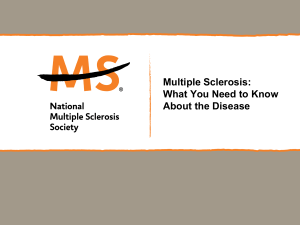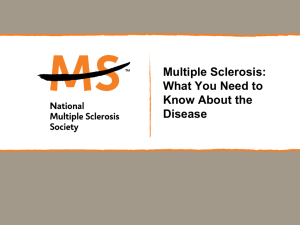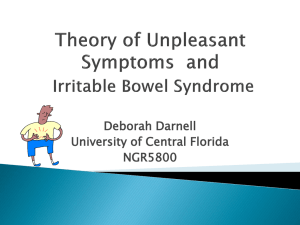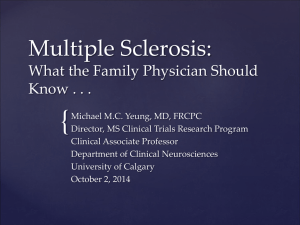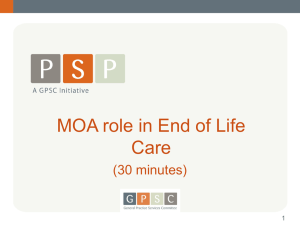Nurses - National Multiple Sclerosis Society
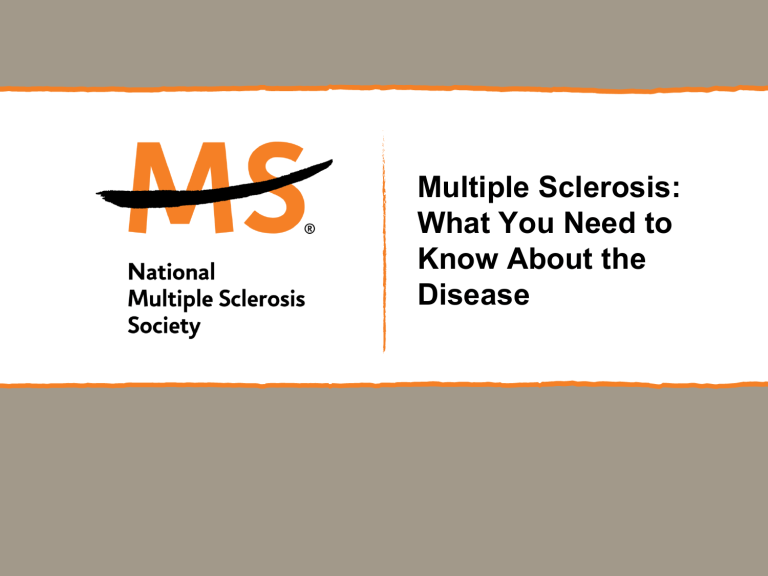
Multiple Sclerosis:
What You Need to
Know About the
Disease
What does MS look like?
• Julia —a 35yo white married mother of 3 who is exhausted all the time and can’t drive because of vision problems and numbness in her feet
• Jackson —a 25yo African-American man who stopped working because he can’t control his bladder or remember what he read in the morning paper
• Maria —a 10yo Hispanic girl who falls down a lot and whose parents just told her she has MS
• Loretta —a 47yo white single woman who moved into a nursing home because she can no longer care for herself
19th Century Highlights
MS-related central nervous system pathology—Jean Cruveilhier, c 1841
Jean-Martin Charcot (1825–1893) described features of MS
What MS Is:
• MS is thought to be a disease of the immune system —perhaps autoimmune.
• The immune system damages the myelin coating around the nerves in the central nervous system
(CNS —brain, spinal cord, and optic nerves) and the nerve fibers themselves.
• Its name comes from the scarring caused by inflammatory attacks at multiple sites in the central nervous system.
What MS Is Not:
• MS is not:
Contagious
Directly inherited
Always severely disabling
Fatal —except in fairly rare instances
• Being diagnosed with MS is not a reason to:
Stop working
Stop doing things that one enjoys
Not have children
What Causes MS?
Genetic
Predisposition
Immune Attack
Environmental
Trigger
Loss of myelin
& nerve fiber
What happens in MS?
“Activated” T cells...
myelinated nerve fiber
...cross the bloodbrain barrier…
…launch attack on myelin & nerve fibers...
…to obstruct nerve signals myelinated nerve fiber
What happens to the myelin and nerve fibers?
What are possible symptoms?
MS symptoms vary between individuals and are unpredictable
Fatigue (most common) Cognitive difficulties
Decreased visual acuity,
(memory, attention, diplopia dysfunction processing)
Pain (neurogenic)
Heat sensitivity
Sexual dysfunction
Spasticity
Paresthesias (tingling,
Gait, balance, and
(numbness, burning) coordination problems
Speech/swallowing problems
(depression, mood swings)
Tremor
How is MS diagnosed?
• MS is a clinical diagnosis:
Signs and symptoms
Medical history
Laboratory tests
• Requires dissemination in time and space:
Space : Evidence of scarring (plaques) in at least two separate areas of the CNS (space)
Time : Evidence that the plaques occurred at different points in time
• There must be no other explanation
What tests may be used to help confirm the diagnosis?
• Magnetic resonance imaging (MRI)
• Visual evoked potentials
(VEP)
• Lumbar puncture
Conventional MRI in MS Clinical Practice
FLAIR
T2
Burden of Disease*
T1 Gd postcontrast
Disease Activity
†
T1 precontrast
Black Holes
†
The strongest correlation with progression of disability
*Reprinted with permission from Miller DH et al. Magnetic Resonance in Multiple Sclerosis . Cambridge: Cambridge University Press; 1997.
† Reprinted with permission from Noseworthy JH et al. N Engl J Med . 2000;343:938-952. Copyright © 2003 Massachusetts Medical Society. All rights reserved.
Evoked Potential Testing
Lumbar Puncture
CSF Anaylsis for Oligoclonal Banding
Oligoclonal Bands
Who gets MS?
• Usually diagnosed between 20 and 50
Occasionally diagnosed in young children and older adults
• More common in women than men (2-3:1)
• Most common in those of Northern European ancestry
More common in Caucasians than Hispanics or
African Americans; rare among Asians
• More common in temperate areas (further from the equator)
What is the genetic factor?
• The risk of getting MS is approximately :
1/750 for the general population (0.1%)
1/40 for person with a close relative with MS (3%)
1/4 for an identical twin (25%)
• 20% of people with MS have a blood relative with MS
The risk is higher in any family in which there are several family members with the disease
(aka multiplex families)
What is the prognosis?
• One hallmark of MS is its unpredictability.
Approximately 1/3 will have a very mild course
Approximately 1/3 will have a moderate course
Approximately 1/3 will become more disabled
• Certain characteristics predict a better outcome:
Female
Onset before age 35
Sensory symptoms
Monofocal rather than multifocal episodes
Complete recovery following a relapse
What are the different patterns (courses) of MS?
• Relapsing-Remitting MS (RRMS)
• Secondary Progressive MS (SPMS)
• Primary Progressive MS (PPMS)
• Progressive-Relapsing MS (PRMS)
Disease Courses in MS
RRMS SPMS
Time
PPMS
Time
PRMS
Time
Adapted with permission from Lublin FD et al. Neurology. 1996;46:907-911.
Time
Relapsing-Remitting MS time
Secondary-Progressive MS time
Primary-Progressive MS time
Progressive-Relapsing MS time
Who is on the MS “Treatment Team”?
• Neurologist
• Urologist
• Nurse
• Physiatrist
• Physical therapist
• Occupational therapist
• Speech/language pathologist
• Psychiatrist
• Psychotherapist
• Neuropsychologist
• Social worker/Care manager
• Pharmacist
What are the treatment strategies?
• Gone are the “Diagnose and Adios” days of MS care
• Management of MS falls into five general categories:
Treatment of relapses (aka exacerbations, flareups, attacks —that last at least 24 hours)
Symptom management
Disease modification
Rehabilitation (maintain/improve function)
Psychosocial support
MS Symptoms vs Relapses…
How Are They Different?
• MS symptoms are chronic or ongoing indicators of MS lesion damage to certain areas of the brain and/or spinal cord
• MS relapses are sudden flare-ups or symptom attacks that typically last several days to several weeks
Joy and Johnston, eds. Multiple Sclerosis: Current Status and Strategies for the Future.
Washington, DC: National Academies Press; 2001
How are relapses treated?
• Not all relapses require treatment
Mild, sensory sx are allowed to resolve on their own.
Sx that interfere with function (e.g., visual or walking problems) are usually treated
• 3-5 day course of IV methylprednisolone — with/without an oral taper of prednisone
High-dose oral steroids used by some neurologists
• Rehabilitation to restore/maintain function
• Psychosocial support
Cycle of MS Symptoms:
Related and Interdependent
Fatigue
Depression
Cognitive function
Sexuality issues
Sleep
Bladder
& Bowel problems
Spasticity
Constipation
MS Symptoms
• Sort out / prioritize
• Remember that MS is not always the culprit
Medication side effect
Another condition
• Refer to appropriate discipline as needed
Effective Approach to Managing MS Symptoms
Prescription medications
Specialists
MS symptom management
Patient education
Physical activities
Managing MS Symptoms
SYMPTOM
Fatigue
Pain
PHARMACOLOGICAL TX
• amantadine
• CNS stimulants: eg, modafinal
• SSRIs: eg, fluoxetine
NURSING INTERVENTIONS
• Assist pt with dosing; titrate up
• Counsel re: naps, work simplification, use of assistive devices (e.g. electric scooter), moderate aerobic activity
• Referral to OT
• Anticonvulsants: carbamazepine, gabapentin, phenytoin
• duloxetine hydrochloride
• Assist pt with dosing; titrate up
• Assess for sedation, ↑fatigue
• Monitor outcomes
Managing MS Symptoms
SYMPTOM PHARMACOLOGICAL TX
Cognitive dysfunction
• As of 2012 no agents have demonstrated efficacy in controlled clinical trials
NURSING INTERVENTIONS
• Refer for neuropsychological testing
•
Consider cognitive remediation
(computer-mediated memory exercises and compensatory strategies)
• Encourage regular exercise and healthy sleeping habits
Managing MS Symptoms
SYMPTOM
Bladder dysfunction
Bowel dysfuntion
PHARMACOLOGICAL TX
• Anticholinergic/antispasmodic: eg, oxybutynin, tolterodine, darifenacin, trospium chloride
• Constipation: stool softeners, bulkforming agents, rectal stimulants, mild laxatives
• Fecal incontinence: anticholinergics
(for hyperreflexive bowel)
NURSING INTERVENTIONS
• Counsel re behavior modification: regular voiding, increased fluids, elimination of irritants (caffeine, alcohol)
• Test for UTI
• Monitor retention
• Teach ISC
• Encourage adequate dietary fiber, fluids, exercise, regular pattern of elimination
• Provide bowel program, diet counseling
Managing MS Symptoms
SYMPTOM
Mobility impairment
(e.g. balance problems, weakness)
Spasticity
PHARMACOLOGICAL TX
• GABA agonists (oral or intrathecal baclofen)
• α- Agonists (tizanidine)
• Anticonvulsants (gabapentin, clonazepam, diazepam)
• botulinum toxin
NURSING INTERVENTIONS
• Refer to PT for exercise program (strengthen muscles & minimize atrophy), assistive devices (canes, braces)
• Education re: mobility aids
• Time doses, titrate up
• Assess for sedation, weakness
• Intrathecal baclofen requires surgical implantation of programmable pump and associated instruction
How is the disease course treated?
• Ten disease-modifying therapies are FDA-approved for relapsing forms of MS:
interferon beta-1a (Avonex ® and Rebif®) [inj.]
interferon beta1b (Betaseron® and Extavia®) [inj.]
glatiramer acetate (Copaxone®) [inj.]
fingolimod (Gilenya ™) [oral]
teriflunomide (Aubagio®) [oral]
dimethyl fumarate (Tecfidera™ [oral}
natalizumab (Tysabri®) [inf]
mitoxantrone (Novantrone®) [inf]
What do the disease-modifying drugs do?
• All reduce attack frequency and severity, reduce scarring on MRI, and probably slow disease progression.
• These medications do not:
Cure the disease
Make people feel better
Alleviate symptoms
How important is early treatment?
• The Society’s National Medical Advisory Committee recommends that treatment be considered as soon as a dx of relapsing MS has been confirmed.
Irreversible damage to axons occurs even in the earliest stages of the illness.
Tx is most effective during early, inflammatory phase
Tx is least effective during later, neurodegenerative phase
• No treatment has been approved for primaryprogressive MS.
Approximately 60% of PwMS are on Tx
What is a clinically-isolated syndrome
(CIS)?
• First neurologic episode caused by demyelination in the CNS
• May be monofocal or multifocal
• May or may not go on to become MS
CIS accompanied by MS-like lesions on MRI is more likely to become MS than CIS without lesions on MRI
• All five injectable medications delay second episode
Treatment Adherence Issues
• Patient readiness is key
• Factors affecting adherence include:
Lack of knowledge about MS
Unrealistic expectations
Denial of illness
Side effects
Cultural factors
Lack of support (medical team, family)
Distrust of medical community
So what do we know about MS?
• MS is a chronic, unpredictable disease.
• The cause of MS is still unknown.
• MS affects each person differently; symptoms vary widely.
• MS is not fatal, contagious, directly inherited, or always disabling.
• Early diagnosis and treatment are important:
Significant, irreversible damage can occur early on.
Available treatments reduce the number of relapses and may slow progression.
• Treatment includes: relapse management, symptom management, disease modification, rehabilitation, emotional support.
What can people do to feel their best?
• Reach out to their support system; no one needs to
be alone in coping with MS.
• Stay connected with others; avoid isolation.
• Become an educated consumer.
• Make thoughtful decisions regarding:
Disclosure
Choice of physician
Employment choices
Financial planning
• Be aware of common emotional reactions.
Society Resources for Your Patients
• 50+ chapters around the country
• Newly-designed Web site
(www.nationalMSsociety.org)
• MS Navigator for information, support, and referrals
(1-800-344-4867)
• Educational programs (in-person, online)
• Support programs (self-help groups, peer and professional counseling, friendly visitors)
• Consultation (legal, employment, insurance, longterm care)
• Financial assistance
Society Resources for Clinicians
• MS Clinical Care Network
Website : www.nationalMSsociety.org/MSClinicalCare
Email : healthprof_info@nmss.org
Clinical consultations with MS specialists
Literature search services
Professional publications
Professional education programs (medical, rehab, nursing, mental health)
Consultation on insurance and long-term care issues
Quarterly e-newsletter for professionals

